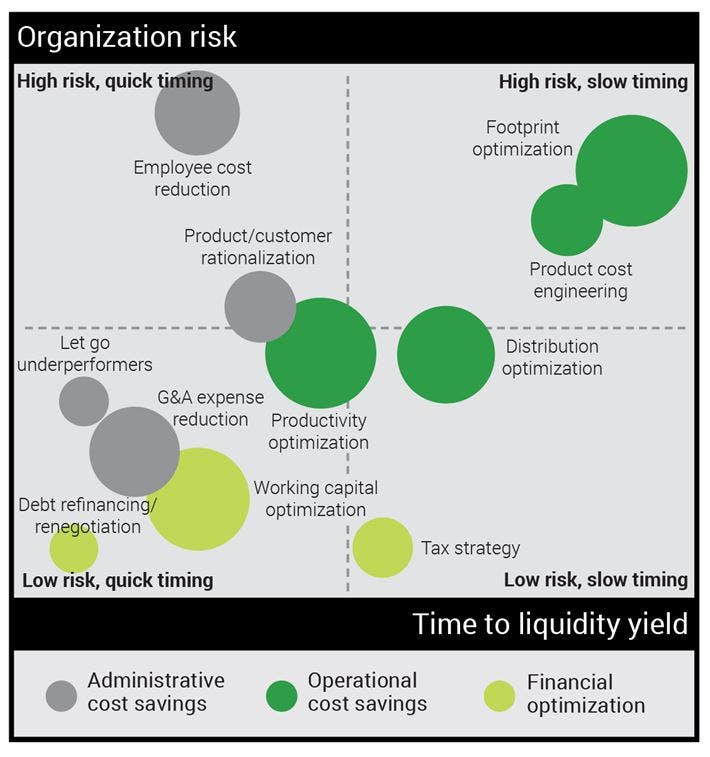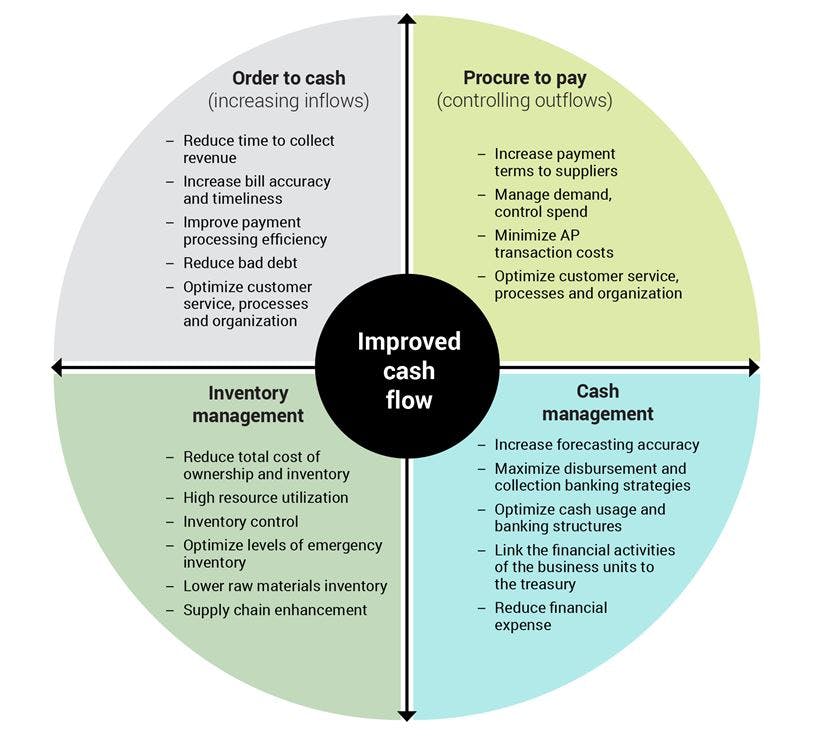
Surviving COVID-19: ideas for unlocking hidden cash
As the economic toll from COVID-19 continues to mount, companies of all sizes are rapidly evolving in order to survive. No one is immune to its impact and business owners are scrambling to evaluate all available options. Despite years of prudent budgeting and cost optimization, companies are now faced with the daunting task of finding creative ways to shore up liquidity. Further complicating the situation, most businesses are not in a position to pursue major investments – such as in more efficient equipment to enable future cost savings, for example – in the current capital-constrained environment. So where does that leave us? In a difficult position, but we’re here to help.
First, there is no magic bullet. Focusing on a risk-based approach, where incremental ideas can yield meaningful liquidity or savings, avoids broadly disrupting the organization. Generally speaking, the larger the opportunity, the larger the organizational impact. Consequently, all activities should be balanced against the overall impact to the organization relative to the time to implement an overall cash yield.
Idea matrix: yield versus risk versus time
Financial liquidity enhancement actions
- Debt refinancing, renegotiations and lease amendments – With a potentially high-yield impact and minimal time to implement, debt term amendments or renegotiations should be at the top of your action list. Lenders are likely not in a position of leverage and are highly likely to engage in dialogue around temporary – or even permanent – relief.
- Working capital optimization – Working capital management optimization can unlock millions of dollars of tied-up capital through optimization of these processes:
- Tax strategy – Efficient tax planning can lead to significant savings, including some that may reduce cost in a timely manner. Below are some incremental actions to consider taking:
-Property taxes administration and appeals
-Reverse sales and use tax audit
-Sales tax bad debts benefit review
-Employment tax recovery review
-Research and development tax credit study
-Transaction costs analysis
-Fixed asset income review
-The Coronavirus Aid, Relief, and Economic Security (CARES) Act tax programs
Operational liquidity enhancement actions
- Footprint optimization:
-Facility mothballing/consolidation – Temporarily deactivate equipment (e.g., machinery) and/or manufacturing facilities during the market downturn to reduce operating costs. Review all physical locations for capacity utilization and needs. Take note of where closures or consolidations might make sense.
-Offshoring/outsourcing – Review all functions (both core business and back office) to see what could be offshored or outsourced, while ensuring existing quality and service levels are maintained or improved. This allows for a reduction in footprint. - Distribution optimization (outsource, planning and logistics) – Reduce costs by internally redesigning the distribution system, while ensuring lead time and service (e.g., fill rate, on-time delivery) are preserved or enhanced, through the following activities:
-Route planning optimization
-Increased truckload capacity utilization
-Warehouse operation streamlining
-Outsourcing distribution - Productivity optimization – Increase factory output through improved production planning (including machinery and labor), change-over shortening and scrap reduction.
- Product cost engineering:
-Vendor consolidation – Strategically reduce supplier base by focusing on top providers to increase buying power, reduce shipping costs and shorten purchasing department workload.
-RFP for direct spend/indirect spend – Conduct a structured, score-based request for proposal processes, especially for large-ticket purchasing, to compare supplier price, service and quality. This ensures you are able to pick the top providers that will allow the organization to generate operating and financial benefits.
Administrative liquidity enhancement actions
- Employee cost reduction – One of the most common cost reductions is reducing headcount. Although it can be a relatively quick method to increase liquidity, it does come with risks, including hurting morale and culture, losing institutional knowledge, reducing service levels to clients, and not being able to react to an upturn in the market. Furlough and temporary salary reductions should be the first form of action before any larger-scale workforce cutbacks.
- Let go of underperformers – Separate from general employee cost, letting go of low performers is “good corporate hygiene” in normal times, but often not taken. In times where liquidity is tight, this should be one of the early steps if possible.
- General and administrative (G&A) expense reduction – Although individual G&A expense categories can be relatively small, most can be reduced quickly. Activities can include:
-Reviewing all marketing expenses, travel expenses and policies, office expenses and business development expenses for possible reductions or eliminations
-Reducing levels of management (spans of control)
-Analyzing work activity levels to see if the back office can be reduced
-Renegotiating or looking for amendments to leases
-Issuing RFPs for G&A vendors or renegotiating terms (e.g., software licenses, telecom and other technology providers, office supplies, travel, and corporate fleet) - Product/customer rationalization – Review all customers, product categories and SKUs to see which ones might be consistently unprofitable (including before the downturn) and could be eliminated.
As outlined, a wider variety of activities and actions can be undertaken to increase liquidity in the short term, medium term and long term. Some will vary in effectiveness and difficulty to implement depending on the industry you are in, the size and breadth of your organization, and where you are in your company’s life cycle. Given the lean budgets and tight purse strings of the past decade, it’s more than likely that cost-cutting strategies were already in place prior to COVID-19. Any activity deemed to be non-critical, such as corporate retreats or free employee meals, has likely already been cut.
If already cutting discretionary spending sounds familiar to you, then focus your efforts on consolidating and optimizing what remains. Leverage this idea matrix to identify if any of these opportunities exist for you.
For more information on this topic, or to learn how Baker Tilly specialists can help, contact our team.


